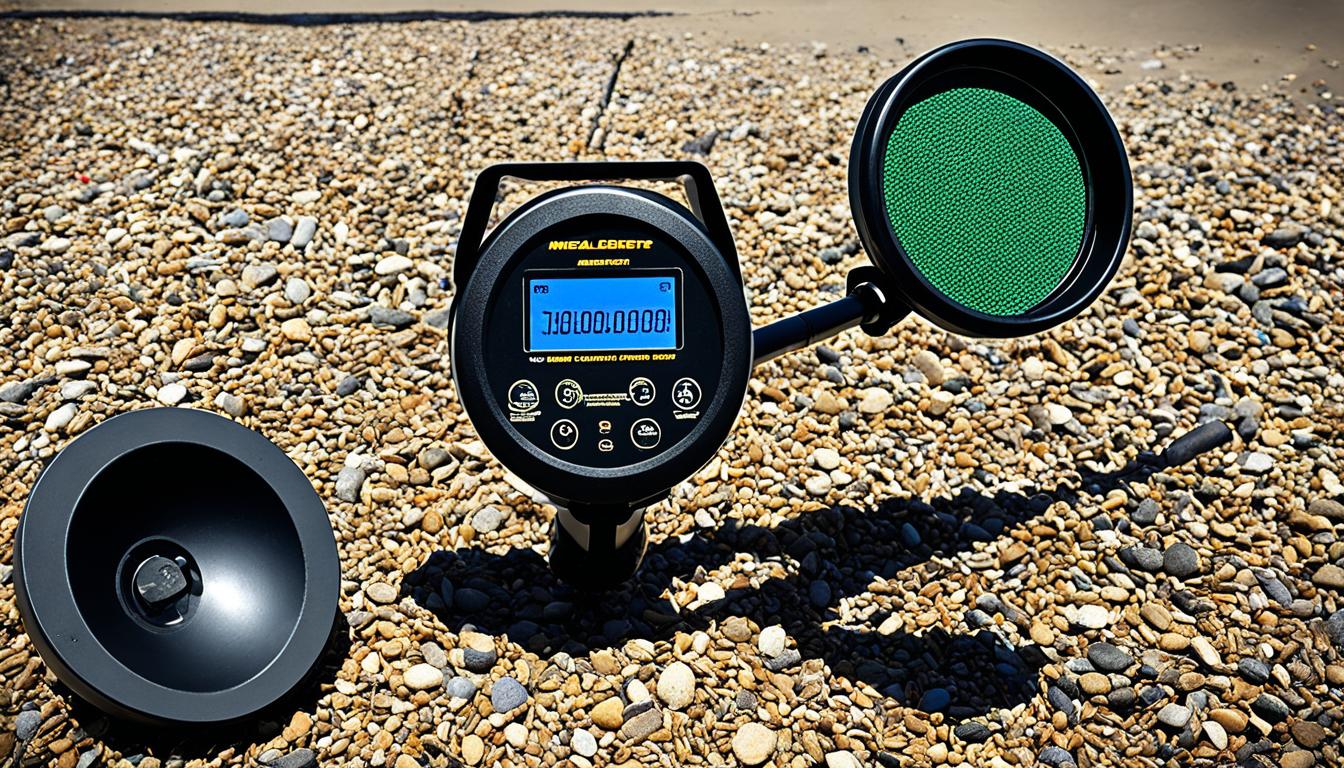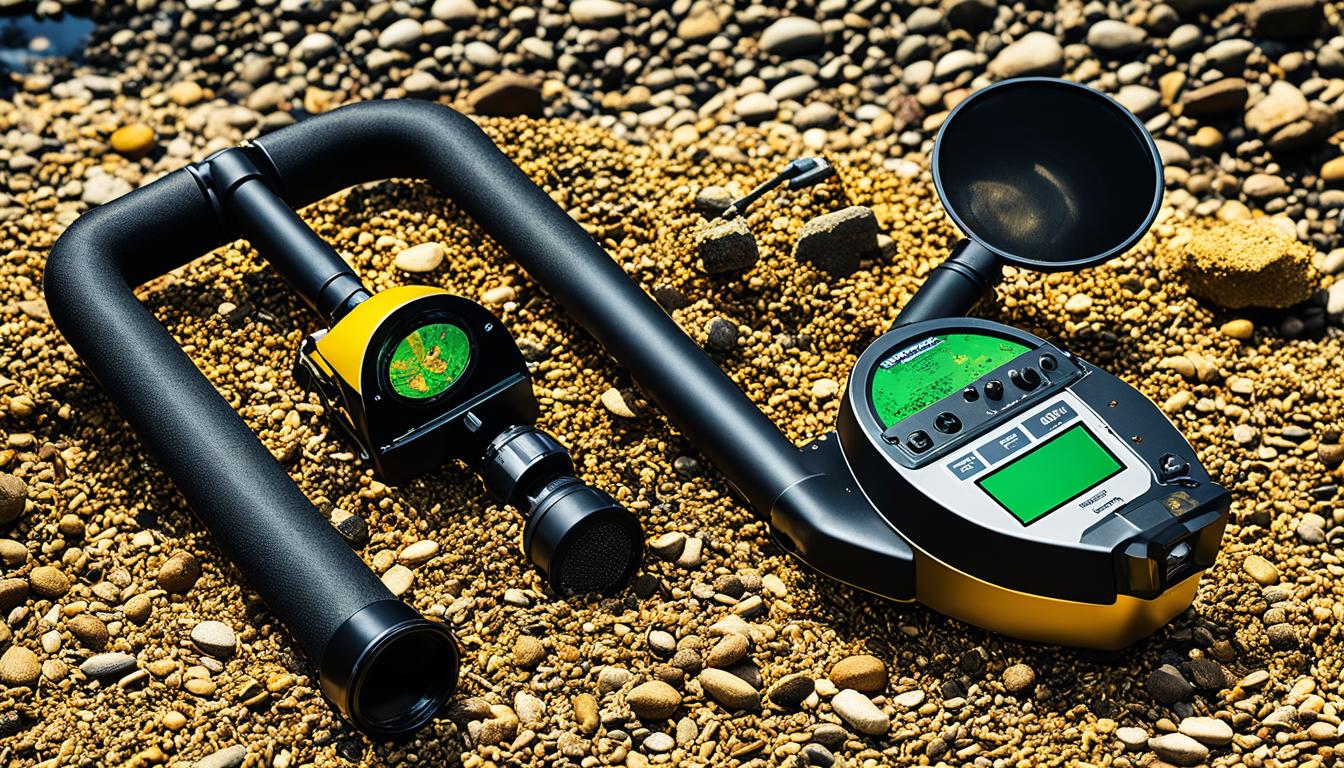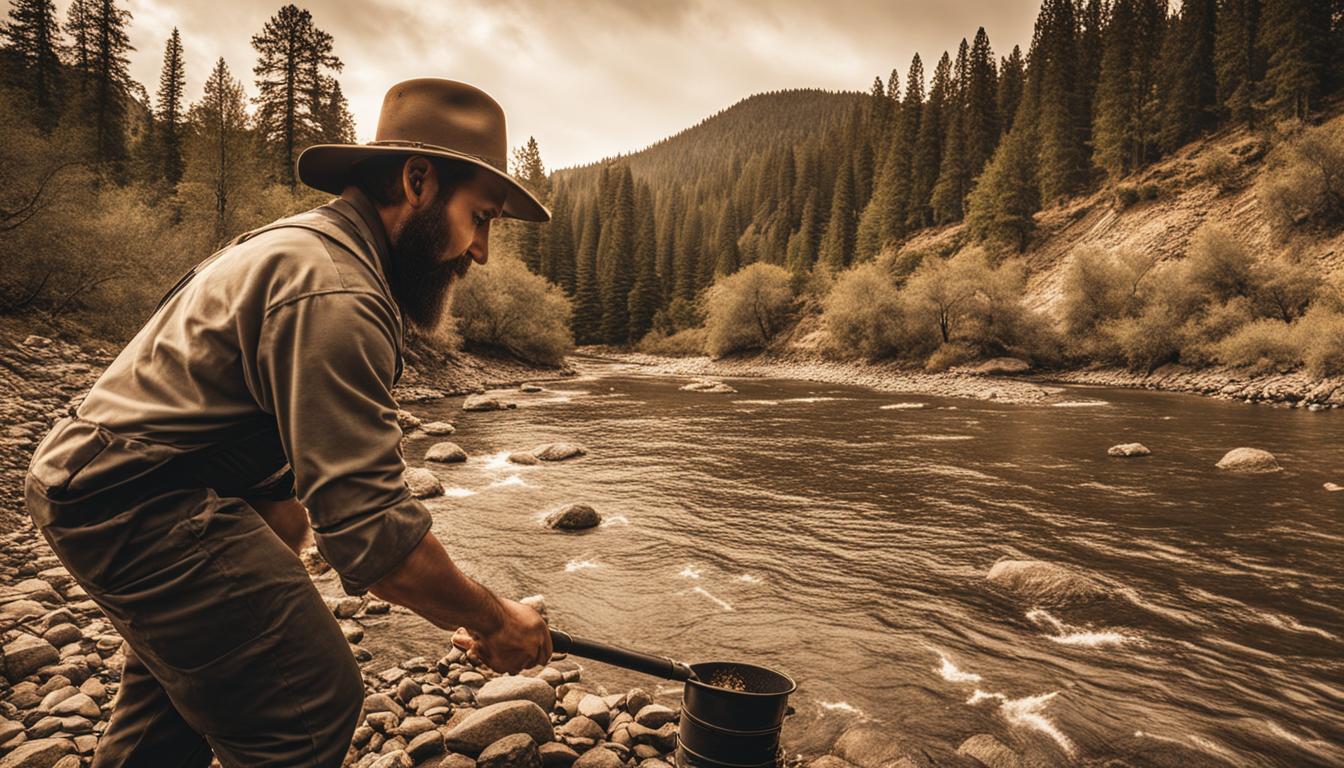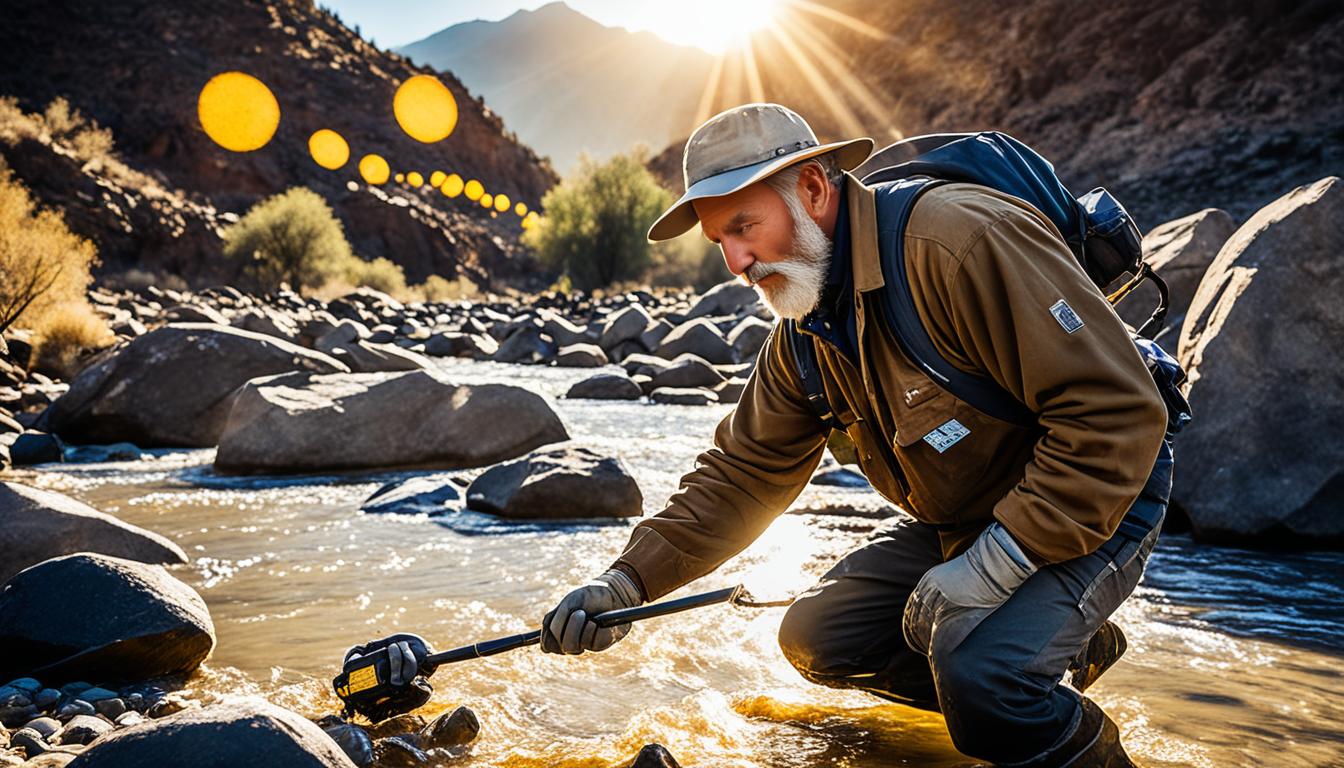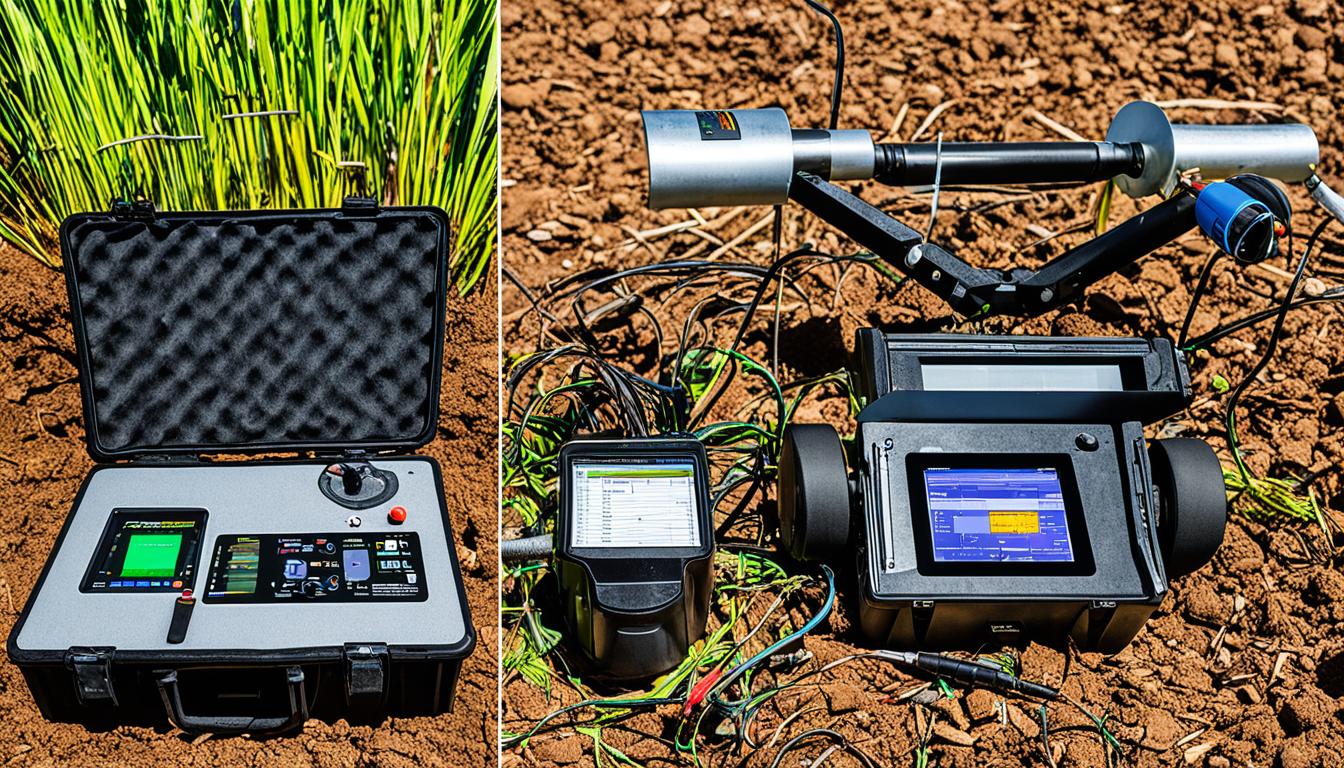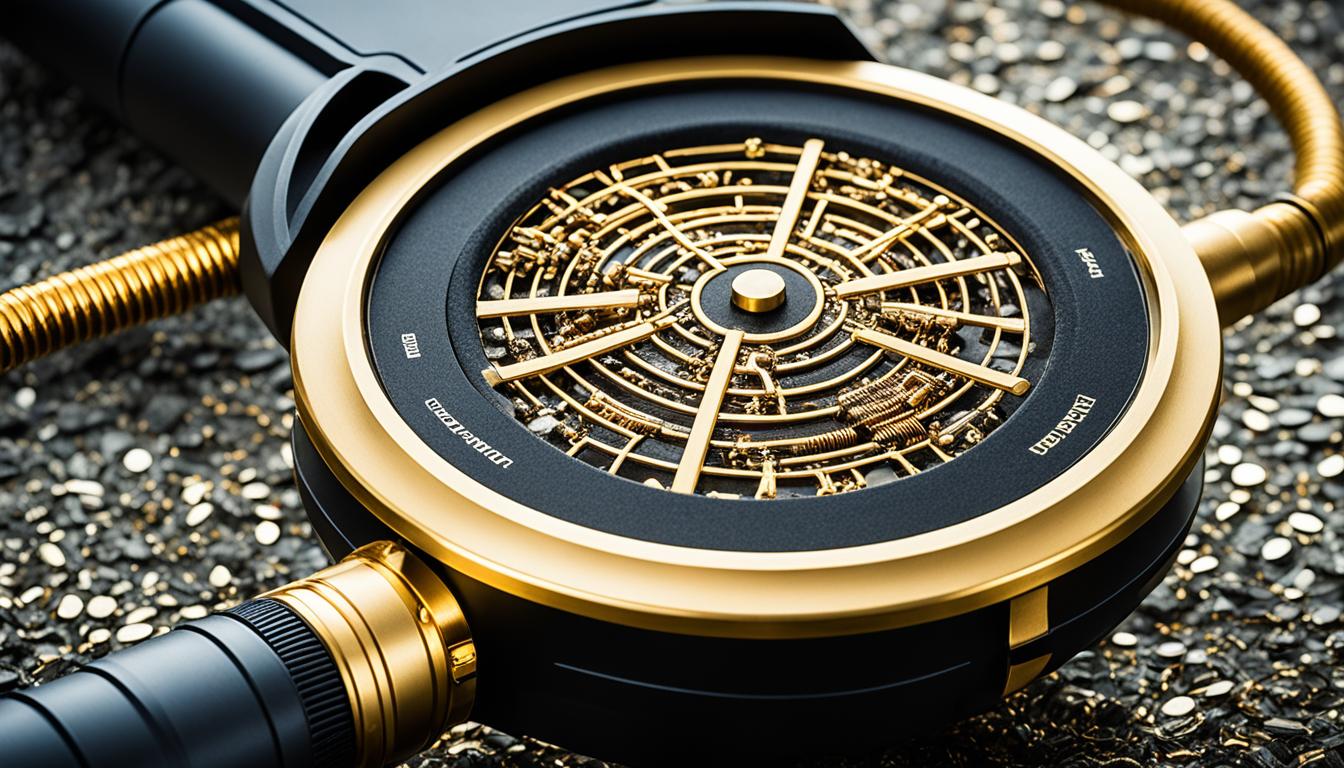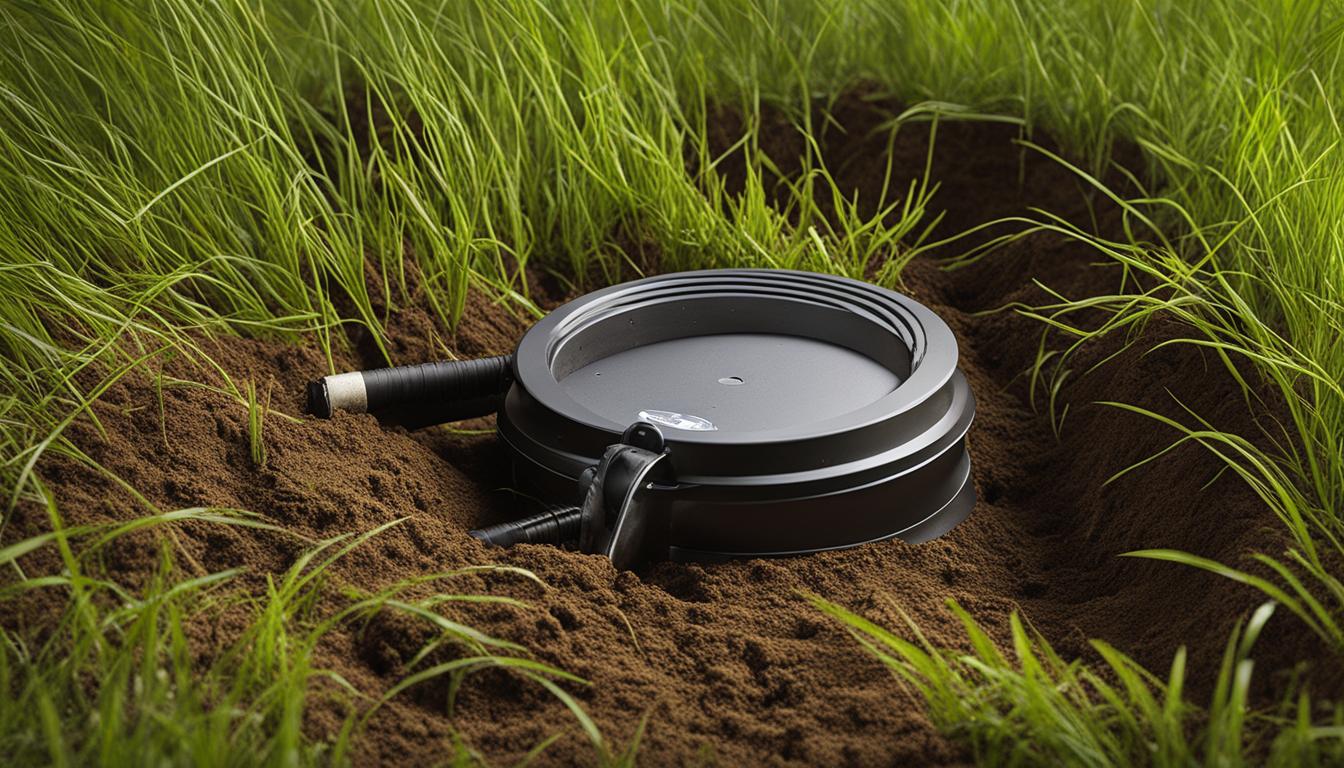
Metal detecting is a popular hobby that allows people to search for hidden treasures. If you’re wondering where to use your metal detector, there are several top gold-producing regions and metal detecting hotspots across the United States that offer great opportunities for finding valuable items. Whether you’re interested in searching in parks, beaches, fields, or other locations, this article will provide you with the information you need to make the most of your metal detecting adventures.
Key Takeaways:
- There are many top gold-producing regions and metal detecting hotspots in the United States.
- Parks, beaches, fields, and historical sites are some of the best places for metal detecting.
- Do your research, obtain permissions, and follow regulations before searching in specific locations.
- Invest in proper equipment and learn metal detecting techniques to increase your chances of finding valuable items.
- Respect the environment, fill in any holes you dig, and prioritize safety during your metal detecting adventures.
Best Places to Find Gold: Rivers, Streams, and Other Bodies of Water
Rivers, streams, and other bodies of water are prime locations for metal detecting enthusiasts in search of gold. These flowing water sources possess a unique ability to wash away lighter materials, leaving behind heavier materials like gold. Whether you’re searching in riverbeds or along the banks of streams, the water dynamics may have exposed valuable nuggets or small flakes of gold.
Additionally, areas with a high concentration of gold ore can be found in proximity to lode mines, caves, creeks, and gulches. These regions also offer promising opportunities for metal detecting enthusiasts hoping to strike gold. The remnants of historical gold mining methods, such as hydraulic mining, sluicing, or dredging, can still be detected in certain areas.
When prospecting in bodies of water, it is important to consider the various factors that may influence the presence of gold. Factors such as water flow, sediment movement, and gold deposition patterns can significantly impact your success. Understanding the geological characteristics and historical mining activities in the target area can help you pinpoint the most promising locations for metal detecting.
Placer Gold in Riverbeds and Along Stream Banks
The flow of water in rivers and streams can expose placer gold, making these areas prime hunting grounds for metal detector enthusiasts. Placer gold refers to gold that has eroded from its source and settled in riverbeds or along stream banks. The movement of water can expose nuggets or small flakes of gold that are waiting to be discovered.
High Concentration of Gold Ore in Proximity to Lode Mines
Areas surrounding lode mines, caves, creeks, and gulches can offer metal detector enthusiasts the opportunity to find gold ore. Gold ore refers to rock or sediment that contains a high concentration of gold. Lode mines are known for their rich deposits of gold ore, which can extend beyond the immediate mining area. By conducting metal detecting activities in these regions, you increase the likelihood of finding valuable specimens and artifacts.
Quote: “Metal detecting in rivers and streams can be an exhilarating experience, as you never know what treasures may be lurking beneath the water’s surface.” – Metal Detecting Enthusiast
Historical Gold Mining Methods: Hydraulic Mining, Sluicing, and Dredging
Exploring areas where historical gold mining methods were practiced can offer a unique insight into the past and the potential for finding gold. Hydraulic mining involves using high-pressure water to erode hillsides and extract gold ore. Sluicing and dredging techniques rely on flowing water to separate gold from other materials, leaving behind deposits that may still yield valuable finds when subjected to metal detector scrutiny.
When metal detecting in these areas, keep in mind that safety precautions and proper permits may be required due to the potentially hazardous nature or protected status of some sites. Always ensure that you are familiar with local regulations and maintain respect for the environment and historical significance of the locations you explore.
Areas with Man-Made Evidence of Mining
When it comes to metal detecting for gold, areas with man-made evidence of mining can hold great potential. These locations, such as old mine shafts, rock piles, and trenches, are clear indicators of past mining activity. The remnants left behind from mining operations create an opportunity for metal detector enthusiasts to uncover valuable items that may have been missed.
Exploring old mine shafts can be especially rewarding, as these were once integral to the mining process and may still contain hidden treasures. Metal detecting in rock piles or near trenches can also yield exciting discoveries, as these areas hold the potential for forgotten or discarded items from mining operations.
Please note that before embarking on your metal detecting adventure in these areas, it’s crucial to obtain proper permission and adhere to any regulations in place. Respecting private property and following local guidelines ensures a responsible and enjoyable experience for all.
Benefits of Metal Detecting in Areas with Man-Made Evidence of Mining
- Higher chances of finding valuable items
- Potential for uncovering artifacts and relics from mining operations
- Opportunity to explore historically significant locations
- Promising areas for detecting gold and other metals
“Metal detecting in areas with man-made evidence of mining provides a unique glimpse into the past and offers the potential to unearth valuable items that may have been left behind.”
By focusing your search in areas with man-made evidence of mining, you increase your chances of discovering valuable artifacts, relics, and even gold. These locations serve as a testament to our rich mining history and present exciting opportunities for metal detector enthusiasts.
Next, we’ll explore areas with a high concentration of gold ore, where the chances of striking gold are even greater.
Areas with a High Concentration of Gold Ore
If you’re passionate about metal detecting and looking for gold, targeting areas with a high concentration of gold ore can greatly increase your chances of finding valuable gold nuggets and other precious items. These locations are known for their rich mineral deposits and are often associated with gold veins and fractured rock.
When metal detecting in areas with a high concentration of gold ore, keep an eye out for signs of other minerals commonly found alongside gold, such as quartz veins. These indicators can lead you to potential hotspots where gold may be present.
Hard rock mining and tunneling are two methods often used to extract gold from these ore-rich areas. By focusing your metal detecting efforts in regions where hard rock mining or tunneling has taken place, you tap into the potential of uncovering hidden treasures that have been left behind.
Here is a list of key features to look for when searching for gold with your metal detector in areas with a high concentration of gold ore:
- Quartz veins
- Fractured rock formations
- Evidence of hard rock mining activities
- Tunnel entrances or shafts
| Key Features | Further Explanation |
|---|---|
| Quartz veins | Gold often accompanies quartz veins, making them a prime location to search for gold deposits. |
| Fractured rock formations | Fractured rock can create pathways for gold to accumulate, increasing the likelihood of finding gold nuggets or flakes. |
| Evidence of hard rock mining activities | Areas where hard rock mining has occurred in the past indicate the presence of gold and offer potential metal detecting opportunities. |
| Tunnel entrances or shafts | Tunnels and mine shafts provide access to gold-rich areas that may have been overlooked by traditional mining methods. |
By focusing on these key features and using your metal detector to search in areas with a high concentration of gold ore, you increase your chances of finding valuable gold nuggets and enhancing your overall metal detecting experience.
Caves, Creeks, and Gulches Surrounding Lode Mines
If you’re searching for gold, don’t overlook the potential of caves, creeks, and gulches surrounding lode mines. These areas, often ignored by traditional mining methods, can be hidden treasure troves for metal detector enthusiasts. By exploring these overlooked spots, you may uncover valuable items missed by previous prospectors.
One fruitful strategy is to focus on detecting along underground waterways. Gold, transported by flowing water, can accumulate in caves, creeks, and gulches, making them particularly promising locations for metal detecting. These underground waterways have the potential to carry gold from its source and deposit it in accessible areas.
Here’s a list of reasons why metal detecting in caves, creeks, and gulches surrounding lode mines can lead to exciting discoveries:
- You may find gold nuggets or flakes that have been dislodged from the lode mine.
- The flowing water in creeks and gulches can concentrate gold, making these areas especially lucrative for metal detecting.
- Exploring caves can reveal hidden treasure caches that may have been overlooked.
- Previous prospectors may have missed valuable items in these less obvious locations.
To give you an idea of what you might discover in these areas, here’s a quote from an experienced metal detectorist:
“I’ve had some of my best finds by exploring the caves, creeks, and gulches surrounding old lode mines. The water transport has helped concentrate the gold, and I’ve found some incredible nuggets and jewelry in these overlooked spots.” – Metal Detector Enthusiast Jones
So, don’t underestimate the potential of caves, creeks, and gulches surrounding lode mines. Grab your metal detector and start exploring these hidden gems for a chance to uncover valuable treasures that have been waiting to be discovered.
Near Important Rock Types Like Granite, Schist, and Gneiss
Certain rock types play a significant role in metal detecting for gold, particularly granite, schist, and gneiss. These rocks are often associated with placer gold deposits, making them prime locations for prospecting. When you target areas near these important rock types, you increase your chances of finding valuable gold. Granite, schist, and gneiss indicate the presence of mineral deposits and are more likely to contain gold.
Using your metal detector near these rock types allows you to focus your search on specific areas that have a higher likelihood of yielding valuable finds. By understanding the geological characteristics of the terrain and utilizing your metal detecting skills, you can make the most of your gold prospecting expeditions.
| Rock Type | Features |
|---|---|
| Granite | Light-colored igneous rock with coarse grains; often found in mountainous regions. |
| Schist | Metamorphic rock with a foliated texture formed from shale or clay minerals; usually found in areas with intense metamorphism. |
| Gneiss | Foliated metamorphic rock with alternating light and dark bands; formed from high-grade regional metamorphism of sedimentary or igneous rocks. |
When exploring metal detecting opportunities near granite, schist, and gneiss formations, remember to research the specific rock types in your target area and how they relate to gold mineralization. This knowledge will help you identify the most productive locations and increase your chances of discovering valuable mineral deposits.
Beaches: Uncovering Lost Treasures in the Sand
Beaches are popular locations for metal detecting due to their high foot traffic and potential for uncovering lost treasures. People frequently visit beaches and may inadvertently drop coins, jewelry, or other valuable items in the sand. Coastal areas are also prone to erosion, which can reveal hidden treasures that have been buried over time.
When metal detecting on beaches, it’s helpful to focus on areas where people gather, such as near beach entrances, volleyball courts, or picnic areas. These spots are more likely to yield valuable finds. Additionally, beaches with a history of beachgoers, such as popular tourist destinations or areas near historical landmarks, can be particularly fruitful.
Before you embark on your metal detecting adventure, it’s essential to check the local rules and regulations regarding metal detecting on beaches. Some beaches may have restrictions or permits required, so make sure to familiarize yourself with the guidelines beforehand.
“I love metal detecting on beaches. You never know what treasures you might find buried in the sand.” – Metal Detecting Enthusiast
To make the most of your beach metal detecting experience, consider these useful tips:
- Choose the right metal detector for beach conditions. Look for models that are specifically designed for saltwater environments and have excellent discrimination features to filter out unwanted signals from minerals or trash.
- Research the history of the beach you plan to visit. Learning about any significant events or past activities that occurred in the area can provide valuable insights into potential treasure hotspots.
- Pick a time when the tide is low. This exposes more areas of the beach, increasing your chances of finding buried treasures.
- Bring a sand scoop or trowel to dig out your targets. These tools help you carefully extract items from the sand without causing damage.
- Follow proper beach etiquette. Remember to fill in any holes you dig and leave the beach as you found it, ensuring that future beachgoers can enjoy the same experience.
With the right equipment, knowledge, and a bit of luck, you could uncover hidden gems and valuable keepsakes on your metal detecting journey along the coastline.

| Pros of Metal Detecting on Beaches | Cons of Metal Detecting on Beaches |
|---|---|
| 1. Higher chances of finding lost coins, jewelry, and other valuable items. | 1. Increased competition from other metal detector enthusiasts. |
| 2. Beaches have a constant influx of new targets due to high foot traffic. | 2. Sand erosion can make it challenging to locate buried treasures. |
| 3. Potential for discovering historical artifacts or relics washed ashore. | 3. Restrictions or permits may be required in some beach areas. |
Parks and Playgrounds: Discovering Forgotten Coins and Jewelry
Parks and playgrounds provide excellent opportunities for metal detecting enthusiasts, especially beginners. These popular public spaces attract a high volume of people, increasing the likelihood of finding lost coins and jewelry.
When scanning parks and playgrounds with your metal detector, focus on areas where people gather, such as picnic tables, benches, and play equipment. These spots are prime locations for accidental item drops. By exploring these areas, you have a greater chance of uncovering forgotten treasures.
Before embarking on your metal detecting adventure, it’s crucial to ensure that metal detecting is allowed in the park or playground. Always respect any rules or guidelines set by local authorities to maintain a positive detecting experience for everyone.
Tips for Metal Detecting in Parks and Playgrounds:
- Be mindful of the environment: When using your metal detector, be careful not to damage any plants, flowers, or property within the park or playground. Respect the area and leave it as you found it.
- Arrive early or stay late: Visiting parks and playgrounds during off-peak hours can improve your chances of finding valuable items. Being the first or last person of the day allows you to detect in areas that haven’t been searched thoroughly.
- Use a pinpointer: A pinpointer is a handheld metal detecting tool that helps locate targets more precisely. It can be especially useful when searching in grassy areas or around play equipment with a lot of metal components.
- Be prepared: Bring essential accessories such as gloves, a small shovel or trowel, a finds pouch, and trash bags to dispose of any litter you may unearth during your search.
A metal detecting enthusiast shares their experience: “I’ve found some incredible old coins and even a few pieces of jewelry while metal detecting in parks. It’s fascinating to think about the stories behind these lost items and the joy they bring when rediscovered.”
Now let’s take a look at the table below, which summarizes the advantages and considerations of metal detecting in parks and playgrounds:
| Advantages | Considerations |
|---|---|
| High foot traffic increases the chances of finding lost coins and jewelry. | Always obtain permission and follow rules and regulations. |
| Frequent item drops in areas where people gather, such as picnic tables and benches. | Respect the environment and leave the area undisturbed. |
| Great for beginners looking to gain experience in metal detecting. | Use a pinpointer to precisely locate targets. |
| Parks and playgrounds offer a variety of potential search areas. | Arrive early or stay late for better chances of finding valuable items. |
So, if you’re eager to start your metal detecting journey or looking for new locations to explore, don’t overlook the possibilities offered by parks and playgrounds. You never know what hidden treasures you might discover!
Historical Sites: Unearthing Relics of the Past
Historical sites provide metal detecting enthusiasts with a unique opportunity to uncover relics that hold a glimpse into the past. From ancient settlements to battlefields and other historically significant locations, these sites hold the potential for discovering valuable artifacts that have long been buried. If you’re interested in metal detecting historical sites, it’s essential to research the history of the area you plan to explore. This will help you focus your efforts on specific areas of archaeological significance, increasing your chances of finding remarkable treasures.
Before embarking on your metal detecting adventure, it’s crucial to obtain permission to detect on historical sites. Ensure you adhere to any regulations or guidelines set by the site administrators to protect the integrity of these valuable locations and preserve their historical significance.

Uncovering buried artifacts at historical sites requires patience, knowledge, and a keen eye for detail. Consider seeking advice from experienced metal detecting enthusiasts or joining metal detecting clubs or forums for valuable insights and tips specific to historical site detecting. Remember, the artifacts you discover not only hold historical value but also contribute to our understanding of the past.
Ghost Towns: Hunting for Hidden Treasures
Ghost towns are a captivating destination for metal detecting enthusiasts. These abandoned settlements hold remnants of the past, offering the potential to uncover valuable items and buried treasures. When people abandoned these towns, they left behind a piece of history waiting to be found. Whether it’s coins, jewelry, or other artifacts, metal detecting in ghost towns can be a rewarding experience.
Researching Ghost Town Locations
Before embarking on your quest to detect in ghost towns, it’s essential to conduct thorough research. Determine the locations of ghost towns in your area or plan a trip to famous abandoned towns known for their historical significance. Online resources, historical societies, and local libraries can provide valuable information on the history and locations of these towns.
Permission and Preservation
Obtaining permission from the landowners before metal detecting in ghost towns is crucial. These sites may be privately owned, and landowners must be respected and approached for permission. Additionally, it’s essential to prioritize the preservation of these unique locations. Adhere to any guidelines or restrictions set by the landowners and ensure that you leave the area undisturbed and as you found it.
By responsibly detecting in ghost towns, you have the opportunity to unearth hidden treasures and contribute to the preservation of these historical sites.
| Advantages | Considerations |
|---|---|
|
|
Private Property: With Permission and Treasure to Find
Metal detecting on private property can be an exciting opportunity to uncover hidden treasures. However, it’s crucial to obtain permission from the landowner before embarking on your metal detecting adventure. Many landowners are open to allowing metal detecting on their property, especially if there is a possibility of finding valuable or historically significant items.
When metal detecting on private property, it’s essential to show respect for the land and follow any rules or guidelines set by the landowner. Always fill in any holes you dig and leave the property as you found it. By demonstrating responsible behavior, you can maintain positive relationships with landowners and potentially gain exclusive access to untapped treasure hunting opportunities.
Obtaining permission from the landowner is crucial when metal detecting on private property. Respect the land, follow the rules, and fill in any holes you dig. Show appreciation for the opportunity to search for hidden treasures.
If you’re unsure how to approach a landowner or request permission, consider these helpful tips:
- Research the property: Before reaching out to the landowner, familiarize yourself with the property’s history and any potential treasure hotspots. This will demonstrate your genuine interest and can help you form a connection with the landowner.
- Introduce yourself: When contacting the landowner, introduce yourself and explain your passion for metal detecting. Express your respect for their property and emphasize that you will follow any rules or guidelines they may have.
- Highlight the benefits: Emphasize the potential benefits of allowing metal detecting on their property. Mention the possibility of uncovering valuable items or artifacts that could enhance their understanding and appreciation of the land’s history.
- Offer something in return: Consider offering a percentage of any valuable finds you discover as a gesture of goodwill. This can show the landowner that you value their permission and can help build a positive relationship.
Remember, each landowner may have different rules and expectations, so it’s crucial to communicate openly and honestly. By approaching private property metal detecting with respect and permission, you have the opportunity to uncover unique and exclusive treasures.
Benefits of Metal Detecting on Private Property
Metal detecting on private property offers several advantages:
- Access to untouched areas: Private property often presents untapped treasure hunting opportunities as these areas may have been largely undisturbed.
- Potential for valuable finds: Owing to limited public access, private property may contain valuable items that have gone unnoticed by other metal detecting enthusiasts.
- Historical significance: Private landowners may possess historical knowledge about their property, enabling you to explore areas of historical significance that are inaccessible to the general public.
- Building relationships: By forming positive relationships with landowners, you may gain long-term access to their property and establish connections within the metal detecting community.
Conclusion
Metal detecting is an exciting and rewarding hobby that allows enthusiasts to explore various locations in search of hidden treasures. By knowing the best places to use your metal detector, you can greatly increase your chances of finding valuable items like gold nuggets, coins, and jewelry.
Whether you prefer searching in rivers, beaches, parks, historical sites, or even private property, it’s important to obtain the necessary permissions and adhere to any regulations in place. Prioritize safety during your metal detecting adventures by researching the areas you plan to visit and investing in the right equipment.
Remember, successful metal detecting relies on a combination of skill, knowledge, and patience. Take the time to learn the appropriate techniques for each location and be prepared for the possibility of digging up not only valuable artifacts, but also items of historical and cultural significance. With determination and a passion for exploration, your metal detecting adventures are sure to be filled with excitement and the thrill of uncovering the past. Happy hunting!
FAQ
Where can I use my metal detector?
You can use your metal detector in a variety of locations such as rivers, streams, bodies of water, areas with man-made evidence of mining, areas with a high concentration of gold ore, caves, creeks, and gulches surrounding lode mines, near important rock types like granite, schist, and gneiss, on beaches, in parks and playgrounds, at historical sites, in ghost towns, and on private property with permission.
What are the best places to find gold with a metal detector?
The best places to find gold with a metal detector are rivers, streams, and other bodies of water, areas with man-made evidence of mining, areas with a high concentration of gold ore, caves, creeks, and gulches surrounding lode mines, and near important rock types like granite, schist, and gneiss.
Are beaches good spots for metal detecting?
Yes, beaches are excellent locations for metal detecting. People frequently visit beaches and may accidentally drop valuable items like coins, jewelry, or other treasures in the sand. Coastal areas are also prone to erosion, which can reveal buried treasures over time.
Can I metal detect in parks and playgrounds?
Yes, parks and playgrounds are great places for metal detecting. These public spaces attract a lot of people, increasing the chances of finding lost coins and jewelry. Look for areas where people gather, such as picnic tables, benches, and play equipment.
Can I metal detect in historical sites?
Metal detecting in historical sites can be a great way to uncover relics from the past. Ancient settlements, battlefields, and other historically significant locations may hold valuable artifacts waiting to be discovered. Always obtain permission before metal detecting on historical sites and follow any regulations or guidelines set by the site administrators.
Are ghost towns good places for metal detecting?
Yes, ghost towns can be fascinating places to metal detect. When people abandoned these towns, they may have left behind valuable items or even buried treasures. Research the locations of ghost towns in your area or plan a trip to famous abandoned towns known for their historical significance. Remember to obtain permission from the landowners before metal detecting in these areas and respect the preservation of these unique locations.
Can I metal detect on private property?
Metal detecting on private property can be an exciting opportunity, but it’s important to obtain permission from the landowner before detecting. Many landowners are willing to allow metal detecting on their property, especially if there is a chance of uncovering valuable or historically significant items. Always be respectful of the property, follow any rules or guidelines set by the landowner, and properly fill in any holes you dig.
Where are the best places for metal detecting?
The best places for metal detecting depend on what you’re looking for. Rivers, streams, beaches, parks, historical sites, ghost towns, and private property are all potential hotspots. Researching the history and geology of an area can help you narrow down your search and increase your chances of finding valuable items.
What should I keep in mind when metal detecting?
When metal detecting, it’s important to obtain permission before detecting on private property or historical sites. Research the rules and regulations of the area you plan to search and respect the preservation of historical locations. Additionally, always fill in any holes you dig and prioritize safety during your metal detecting adventures.
Source Links
- https://www.pinpointermetaldetector.com/articles/best-places-to-metal-detect-for-gold
- https://www.metaldetector.com/blogs/new_blog/the-best-places-to-find-gold
- https://modernmetaldetectors.com/blogs/news/the-top-10-places-to-metal-detect?custom=Educational Resources

Meet Ryan Conlon, the passionate owner and driving force behind Pan for Treasure.
With an unwavering love for the art of gold panning, Ryan has transformed his enthusiasm into a thriving community hub for fellow treasure seekers. [email protected]
A seasoned gold panning enthusiast, Ryan’s journey began with a simple pan and a dream, evolving into a deep appreciation for the history, geology, and thrill of uncovering precious metals.


